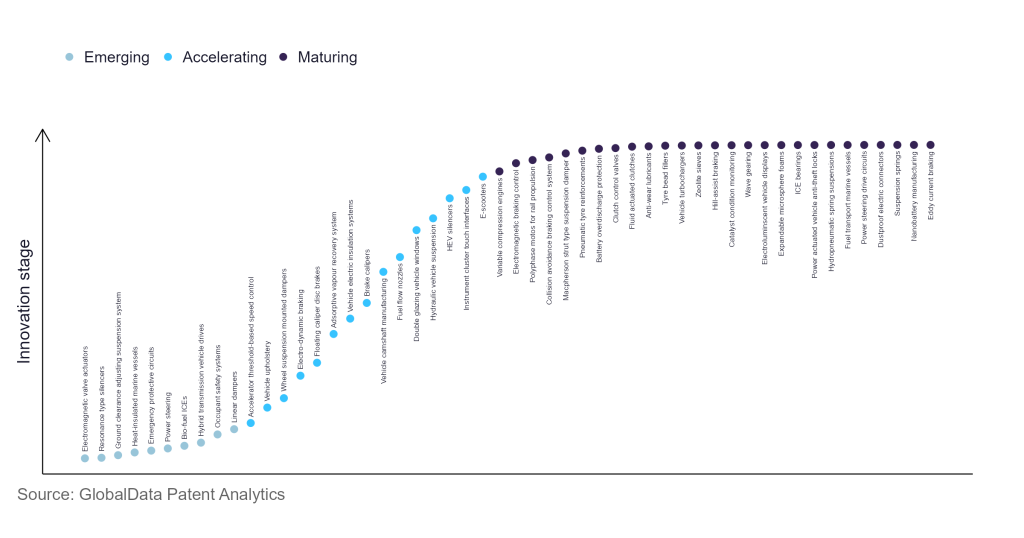The automotive industry continues to be a hotbed of innovation, with activity driven by stringent safety regulations, safety concerns, and need to reduce carbon emissions, and growing importance of technologies such as integrated brake controls (IBC) and carbon ceramic brakes. In the last three years alone, there have been over 1.2 million patents filed and granted in the automotive industry, according to GlobalData’s report on Innovation in Automotive: Electromagnetic braking control. Buy the report here.
However, not all innovations are equal and nor do they follow a constant upward trend. Instead, their evolution takes the form of an S-shaped curve that reflects their typical lifecycle from early emergence to accelerating adoption, before finally stabilising and reaching maturity.
Identifying where a particular innovation is on this journey, especially those that are in the emerging and accelerating stages, is essential for understanding their current level of adoption and the likely future trajectory and impact they will have.
290+ innovations will shape the automotive industry
According to GlobalData’s Technology Foresights, which plots the S-curve for the automotive industry using innovation intensity models built on over 619,000 patents, there are 290+ innovation areas that will shape the future of the industry.
Within the emerging innovation stage, resilient spoke wheels, auto-transmission lubrication circuits, and ignition switching engines are disruptive technologies that are in the early stages of application and should be tracked closely. Engine purge actuators, electro-dynamic braking, and adsorptive vapour recovery system estimation are some of the accelerating innovation areas, where adoption has been steadily increasing. Among maturing innovation areas are collision avoidance braking control system and direct injection type engines, which are now well established in the industry.
Innovation S-curve for the automotive industry

Electromagnetic braking control is a key innovation area in automotive
Electromagnetic brakes are also called electro-mechanical brakes or EM brakes. They reduce or halt motion by utilising electromagnetic force to apply mechanical resistance, or friction. Electrical current passes through a coil on the brakes to develop a magnetic field strong enough to shift an armature on or off a magnetic face.
GlobalData’s analysis also uncovers the companies at the forefront of each innovation area and assesses the potential reach and impact of their patenting activity across different applications and geographies. According to GlobalData, there are 50+ companies, spanning technology vendors, established automotive companies, and up-and-coming start-ups engaged in the development and application of electromagnetic braking control.
Key players in electromagnetic braking control – a disruptive innovation in the automotive industry
‘Application diversity’ measures the number of different applications identified for each relevant patent and broadly splits companies into either ‘niche’ or ‘diversified’ innovators.
‘Geographic reach’ refers to the number of different countries each relevant patent is registered in and reflects the breadth of geographic application intended, ranging from ‘global’ to ‘local’.
Patent volumes related to electromagnetic braking control
Source: GlobalData Patent Analytics
Toyota is a key player in the electromagnetic braking control innovation area. Electromagnetic brakes are used on several of the company’s hybrid Charlotte Toyota vehicles. The electromagnetic brakes work by connecting to an electric motor and recouping energy as they’re used making them more efficient. Hitachi, Nissan and Honda are some of the other key players.
To further understand the key themes and technologies disrupting the automotive industry, access GlobalData’s latest thematic research report on Automotive.
Data Insights
From

The gold standard of business intelligence.
Blending expert knowledge with cutting-edge technology, GlobalData’s unrivalled proprietary data will enable you to decode what’s happening in your market. You can make better informed decisions and gain a future-proof advantage over your competitors.



